Different Types of Organisations with Their Purposes and Legal Structures
VerifiedAdded on 2023/01/05
|13
|3581
|87
AI Summary
This document provides an overview of different types of organisations, including public sector organisations, private sector organisations, and voluntary organisations. It discusses their purposes, legal structures, and interrelationship between organisational functions. It also explores the positive and negative impact of PESTLE analysis on the macro environment of public and private sector organisations. The document is relevant for students studying business and management courses.
Contribute Materials
Your contribution can guide someone’s learning journey. Share your
documents today.

Business and the business
Environment
Environment
Secure Best Marks with AI Grader
Need help grading? Try our AI Grader for instant feedback on your assignments.
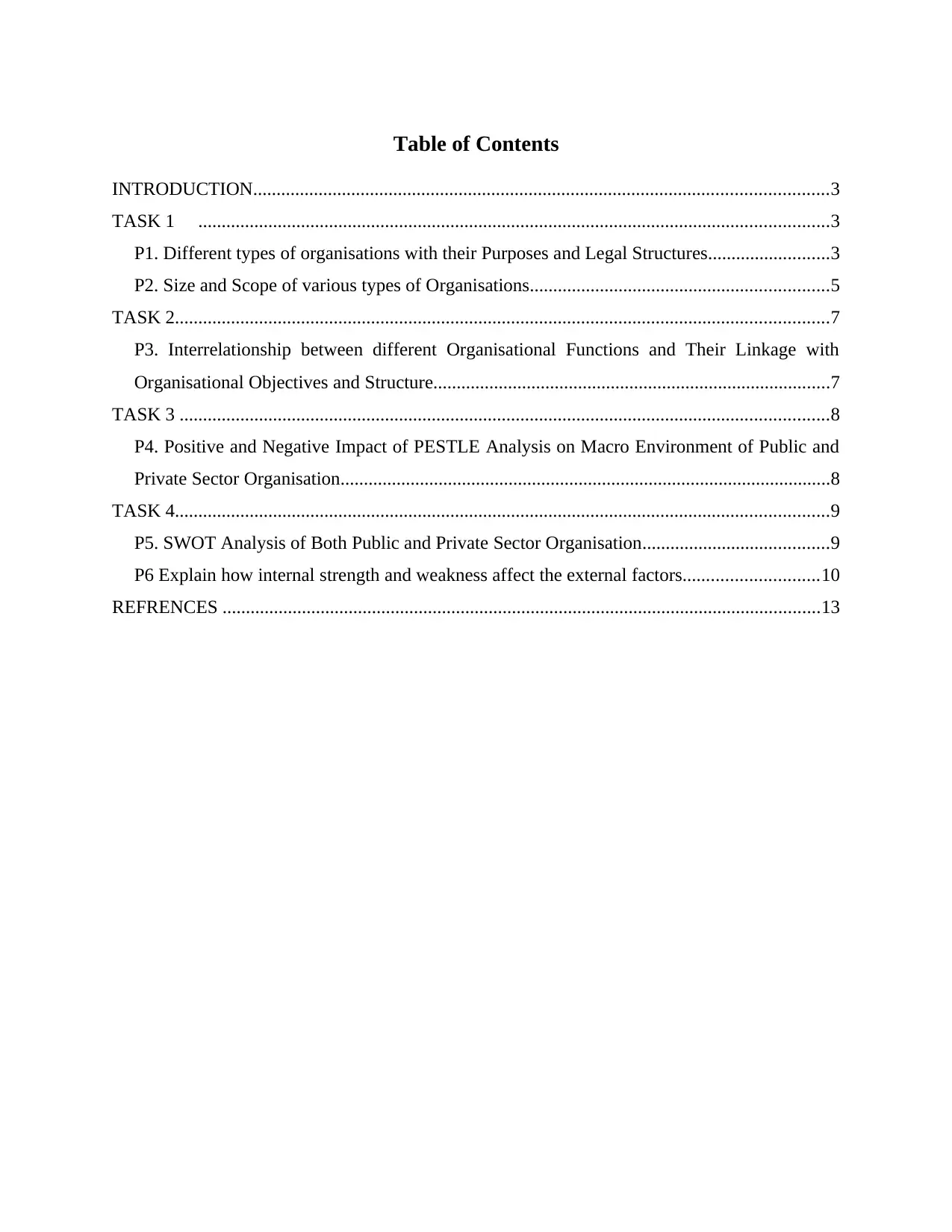
Table of Contents
INTRODUCTION...........................................................................................................................3
TASK 1 .......................................................................................................................................3
P1. Different types of organisations with their Purposes and Legal Structures..........................3
P2. Size and Scope of various types of Organisations................................................................5
TASK 2............................................................................................................................................7
P3. Interrelationship between different Organisational Functions and Their Linkage with
Organisational Objectives and Structure.....................................................................................7
TASK 3 ...........................................................................................................................................8
P4. Positive and Negative Impact of PESTLE Analysis on Macro Environment of Public and
Private Sector Organisation.........................................................................................................8
TASK 4............................................................................................................................................9
P5. SWOT Analysis of Both Public and Private Sector Organisation........................................9
P6 Explain how internal strength and weakness affect the external factors.............................10
REFRENCES ................................................................................................................................13
INTRODUCTION...........................................................................................................................3
TASK 1 .......................................................................................................................................3
P1. Different types of organisations with their Purposes and Legal Structures..........................3
P2. Size and Scope of various types of Organisations................................................................5
TASK 2............................................................................................................................................7
P3. Interrelationship between different Organisational Functions and Their Linkage with
Organisational Objectives and Structure.....................................................................................7
TASK 3 ...........................................................................................................................................8
P4. Positive and Negative Impact of PESTLE Analysis on Macro Environment of Public and
Private Sector Organisation.........................................................................................................8
TASK 4............................................................................................................................................9
P5. SWOT Analysis of Both Public and Private Sector Organisation........................................9
P6 Explain how internal strength and weakness affect the external factors.............................10
REFRENCES ................................................................................................................................13
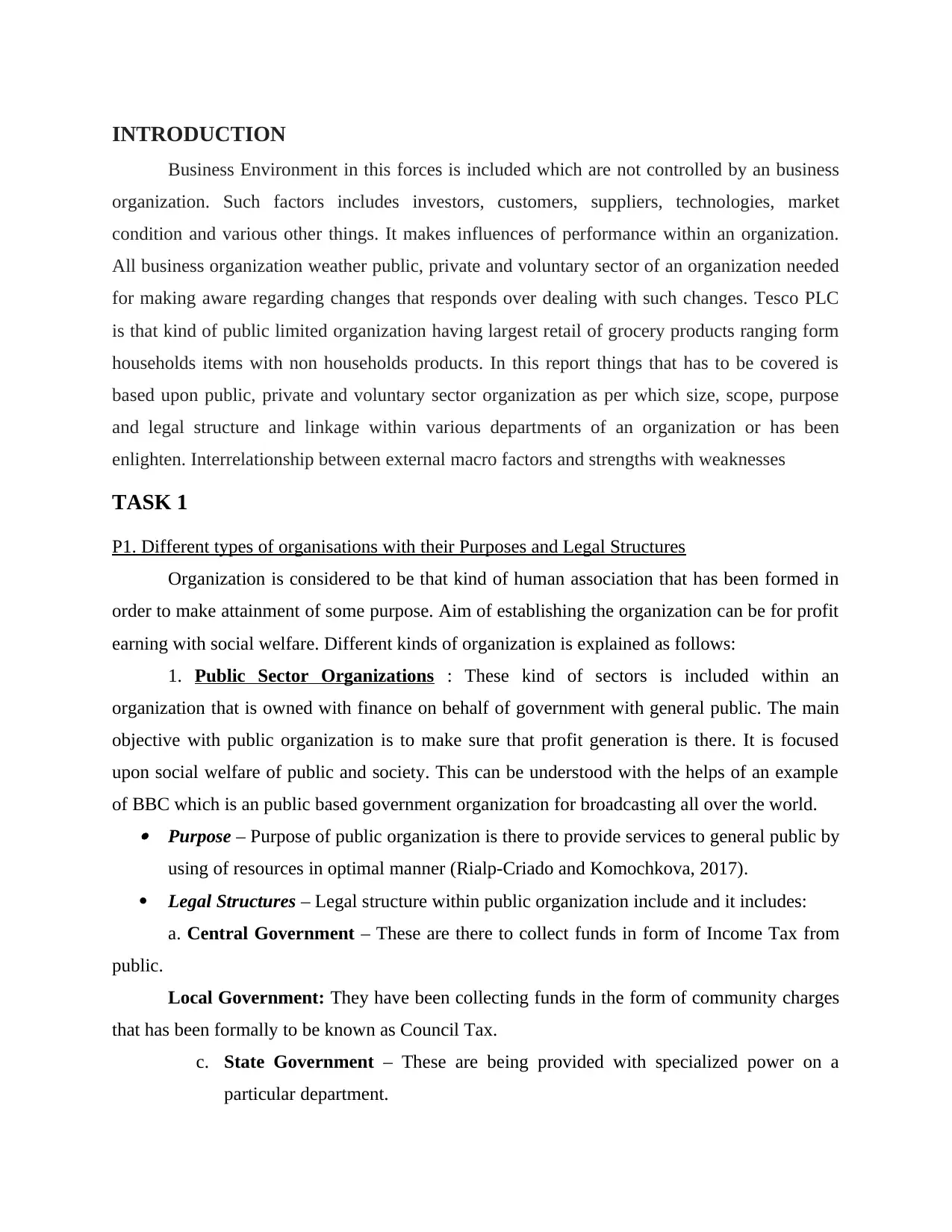
INTRODUCTION
Business Environment in this forces is included which are not controlled by an business
organization. Such factors includes investors, customers, suppliers, technologies, market
condition and various other things. It makes influences of performance within an organization.
All business organization weather public, private and voluntary sector of an organization needed
for making aware regarding changes that responds over dealing with such changes. Tesco PLC
is that kind of public limited organization having largest retail of grocery products ranging form
households items with non households products. In this report things that has to be covered is
based upon public, private and voluntary sector organization as per which size, scope, purpose
and legal structure and linkage within various departments of an organization or has been
enlighten. Interrelationship between external macro factors and strengths with weaknesses
TASK 1
P1. Different types of organisations with their Purposes and Legal Structures
Organization is considered to be that kind of human association that has been formed in
order to make attainment of some purpose. Aim of establishing the organization can be for profit
earning with social welfare. Different kinds of organization is explained as follows:
1. Public Sector Organizations : These kind of sectors is included within an
organization that is owned with finance on behalf of government with general public. The main
objective with public organization is to make sure that profit generation is there. It is focused
upon social welfare of public and society. This can be understood with the helps of an example
of BBC which is an public based government organization for broadcasting all over the world. Purpose – Purpose of public organization is there to provide services to general public by
using of resources in optimal manner (Rialp-Criado and Komochkova, 2017).
Legal Structures – Legal structure within public organization include and it includes:
a. Central Government – These are there to collect funds in form of Income Tax from
public.
Local Government: They have been collecting funds in the form of community charges
that has been formally to be known as Council Tax.
c. State Government – These are being provided with specialized power on a
particular department.
Business Environment in this forces is included which are not controlled by an business
organization. Such factors includes investors, customers, suppliers, technologies, market
condition and various other things. It makes influences of performance within an organization.
All business organization weather public, private and voluntary sector of an organization needed
for making aware regarding changes that responds over dealing with such changes. Tesco PLC
is that kind of public limited organization having largest retail of grocery products ranging form
households items with non households products. In this report things that has to be covered is
based upon public, private and voluntary sector organization as per which size, scope, purpose
and legal structure and linkage within various departments of an organization or has been
enlighten. Interrelationship between external macro factors and strengths with weaknesses
TASK 1
P1. Different types of organisations with their Purposes and Legal Structures
Organization is considered to be that kind of human association that has been formed in
order to make attainment of some purpose. Aim of establishing the organization can be for profit
earning with social welfare. Different kinds of organization is explained as follows:
1. Public Sector Organizations : These kind of sectors is included within an
organization that is owned with finance on behalf of government with general public. The main
objective with public organization is to make sure that profit generation is there. It is focused
upon social welfare of public and society. This can be understood with the helps of an example
of BBC which is an public based government organization for broadcasting all over the world. Purpose – Purpose of public organization is there to provide services to general public by
using of resources in optimal manner (Rialp-Criado and Komochkova, 2017).
Legal Structures – Legal structure within public organization include and it includes:
a. Central Government – These are there to collect funds in form of Income Tax from
public.
Local Government: They have been collecting funds in the form of community charges
that has been formally to be known as Council Tax.
c. State Government – These are being provided with specialized power on a
particular department.
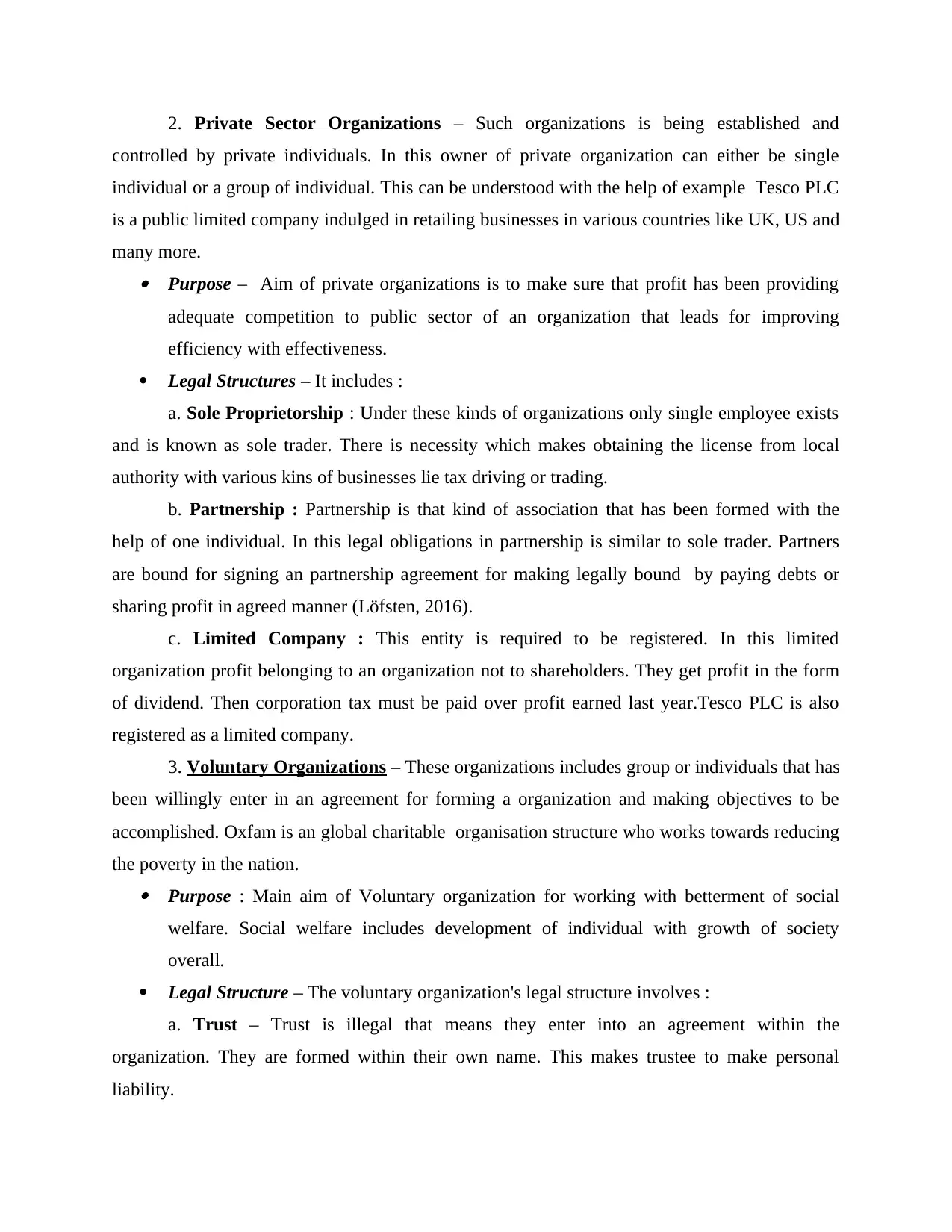
2. Private Sector Organizations – Such organizations is being established and
controlled by private individuals. In this owner of private organization can either be single
individual or a group of individual. This can be understood with the help of example Tesco PLC
is a public limited company indulged in retailing businesses in various countries like UK, US and
many more. Purpose – Aim of private organizations is to make sure that profit has been providing
adequate competition to public sector of an organization that leads for improving
efficiency with effectiveness.
Legal Structures – It includes :
a. Sole Proprietorship : Under these kinds of organizations only single employee exists
and is known as sole trader. There is necessity which makes obtaining the license from local
authority with various kins of businesses lie tax driving or trading.
b. Partnership : Partnership is that kind of association that has been formed with the
help of one individual. In this legal obligations in partnership is similar to sole trader. Partners
are bound for signing an partnership agreement for making legally bound by paying debts or
sharing profit in agreed manner (Löfsten, 2016).
c. Limited Company : This entity is required to be registered. In this limited
organization profit belonging to an organization not to shareholders. They get profit in the form
of dividend. Then corporation tax must be paid over profit earned last year.Tesco PLC is also
registered as a limited company.
3. Voluntary Organizations – These organizations includes group or individuals that has
been willingly enter in an agreement for forming a organization and making objectives to be
accomplished. Oxfam is an global charitable organisation structure who works towards reducing
the poverty in the nation. Purpose : Main aim of Voluntary organization for working with betterment of social
welfare. Social welfare includes development of individual with growth of society
overall.
Legal Structure – The voluntary organization's legal structure involves :
a. Trust – Trust is illegal that means they enter into an agreement within the
organization. They are formed within their own name. This makes trustee to make personal
liability.
controlled by private individuals. In this owner of private organization can either be single
individual or a group of individual. This can be understood with the help of example Tesco PLC
is a public limited company indulged in retailing businesses in various countries like UK, US and
many more. Purpose – Aim of private organizations is to make sure that profit has been providing
adequate competition to public sector of an organization that leads for improving
efficiency with effectiveness.
Legal Structures – It includes :
a. Sole Proprietorship : Under these kinds of organizations only single employee exists
and is known as sole trader. There is necessity which makes obtaining the license from local
authority with various kins of businesses lie tax driving or trading.
b. Partnership : Partnership is that kind of association that has been formed with the
help of one individual. In this legal obligations in partnership is similar to sole trader. Partners
are bound for signing an partnership agreement for making legally bound by paying debts or
sharing profit in agreed manner (Löfsten, 2016).
c. Limited Company : This entity is required to be registered. In this limited
organization profit belonging to an organization not to shareholders. They get profit in the form
of dividend. Then corporation tax must be paid over profit earned last year.Tesco PLC is also
registered as a limited company.
3. Voluntary Organizations – These organizations includes group or individuals that has
been willingly enter in an agreement for forming a organization and making objectives to be
accomplished. Oxfam is an global charitable organisation structure who works towards reducing
the poverty in the nation. Purpose : Main aim of Voluntary organization for working with betterment of social
welfare. Social welfare includes development of individual with growth of society
overall.
Legal Structure – The voluntary organization's legal structure involves :
a. Trust – Trust is illegal that means they enter into an agreement within the
organization. They are formed within their own name. This makes trustee to make personal
liability.
Secure Best Marks with AI Grader
Need help grading? Try our AI Grader for instant feedback on your assignments.
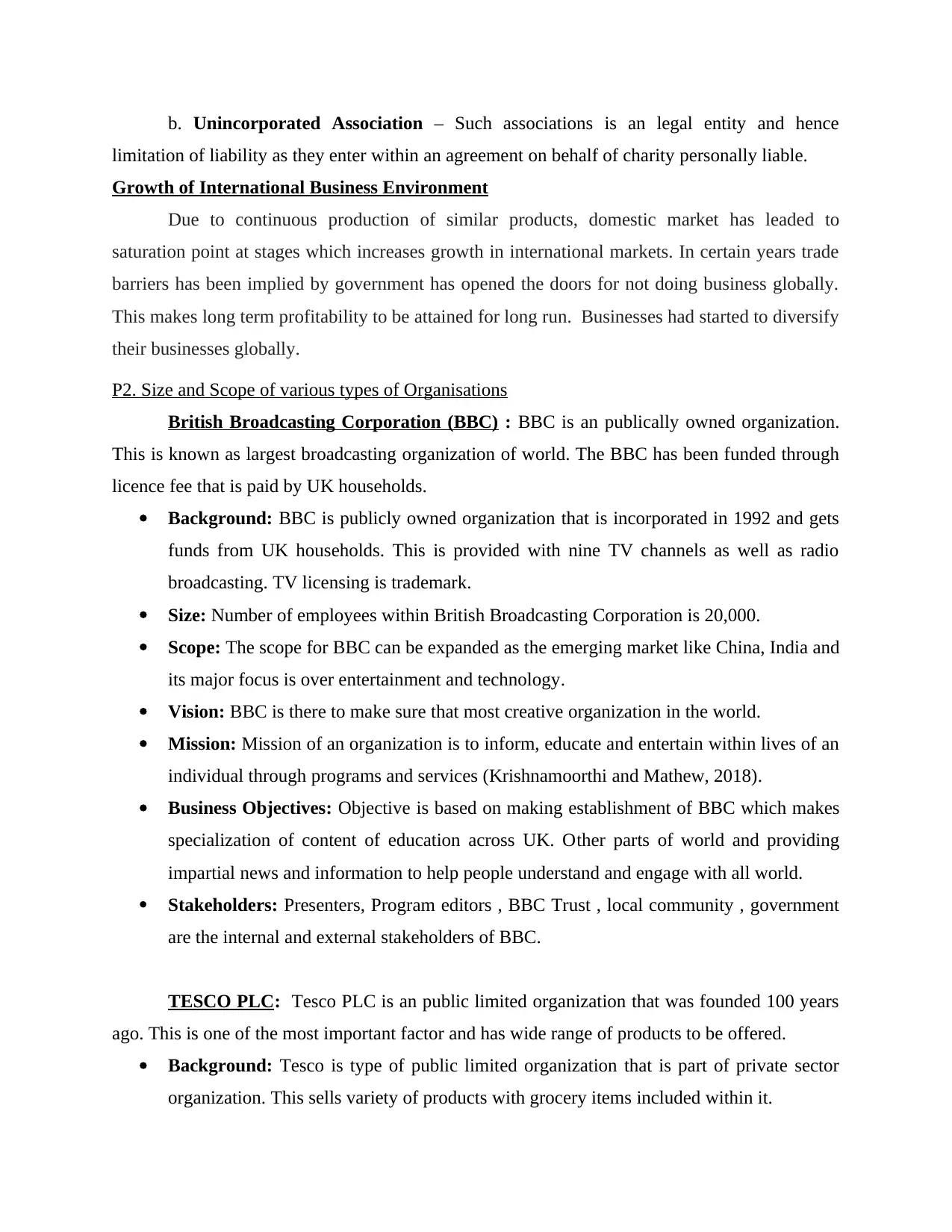
b. Unincorporated Association – Such associations is an legal entity and hence
limitation of liability as they enter within an agreement on behalf of charity personally liable.
Growth of International Business Environment
Due to continuous production of similar products, domestic market has leaded to
saturation point at stages which increases growth in international markets. In certain years trade
barriers has been implied by government has opened the doors for not doing business globally.
This makes long term profitability to be attained for long run. Businesses had started to diversify
their businesses globally.
P2. Size and Scope of various types of Organisations
British Broadcasting Corporation (BBC) : BBC is an publically owned organization.
This is known as largest broadcasting organization of world. The BBC has been funded through
licence fee that is paid by UK households.
Background: BBC is publicly owned organization that is incorporated in 1992 and gets
funds from UK households. This is provided with nine TV channels as well as radio
broadcasting. TV licensing is trademark.
Size: Number of employees within British Broadcasting Corporation is 20,000.
Scope: The scope for BBC can be expanded as the emerging market like China, India and
its major focus is over entertainment and technology.
Vision: BBC is there to make sure that most creative organization in the world.
Mission: Mission of an organization is to inform, educate and entertain within lives of an
individual through programs and services (Krishnamoorthi and Mathew, 2018).
Business Objectives: Objective is based on making establishment of BBC which makes
specialization of content of education across UK. Other parts of world and providing
impartial news and information to help people understand and engage with all world.
Stakeholders: Presenters, Program editors , BBC Trust , local community , government
are the internal and external stakeholders of BBC.
TESCO PLC: Tesco PLC is an public limited organization that was founded 100 years
ago. This is one of the most important factor and has wide range of products to be offered.
Background: Tesco is type of public limited organization that is part of private sector
organization. This sells variety of products with grocery items included within it.
limitation of liability as they enter within an agreement on behalf of charity personally liable.
Growth of International Business Environment
Due to continuous production of similar products, domestic market has leaded to
saturation point at stages which increases growth in international markets. In certain years trade
barriers has been implied by government has opened the doors for not doing business globally.
This makes long term profitability to be attained for long run. Businesses had started to diversify
their businesses globally.
P2. Size and Scope of various types of Organisations
British Broadcasting Corporation (BBC) : BBC is an publically owned organization.
This is known as largest broadcasting organization of world. The BBC has been funded through
licence fee that is paid by UK households.
Background: BBC is publicly owned organization that is incorporated in 1992 and gets
funds from UK households. This is provided with nine TV channels as well as radio
broadcasting. TV licensing is trademark.
Size: Number of employees within British Broadcasting Corporation is 20,000.
Scope: The scope for BBC can be expanded as the emerging market like China, India and
its major focus is over entertainment and technology.
Vision: BBC is there to make sure that most creative organization in the world.
Mission: Mission of an organization is to inform, educate and entertain within lives of an
individual through programs and services (Krishnamoorthi and Mathew, 2018).
Business Objectives: Objective is based on making establishment of BBC which makes
specialization of content of education across UK. Other parts of world and providing
impartial news and information to help people understand and engage with all world.
Stakeholders: Presenters, Program editors , BBC Trust , local community , government
are the internal and external stakeholders of BBC.
TESCO PLC: Tesco PLC is an public limited organization that was founded 100 years
ago. This is one of the most important factor and has wide range of products to be offered.
Background: Tesco is type of public limited organization that is part of private sector
organization. This sells variety of products with grocery items included within it.
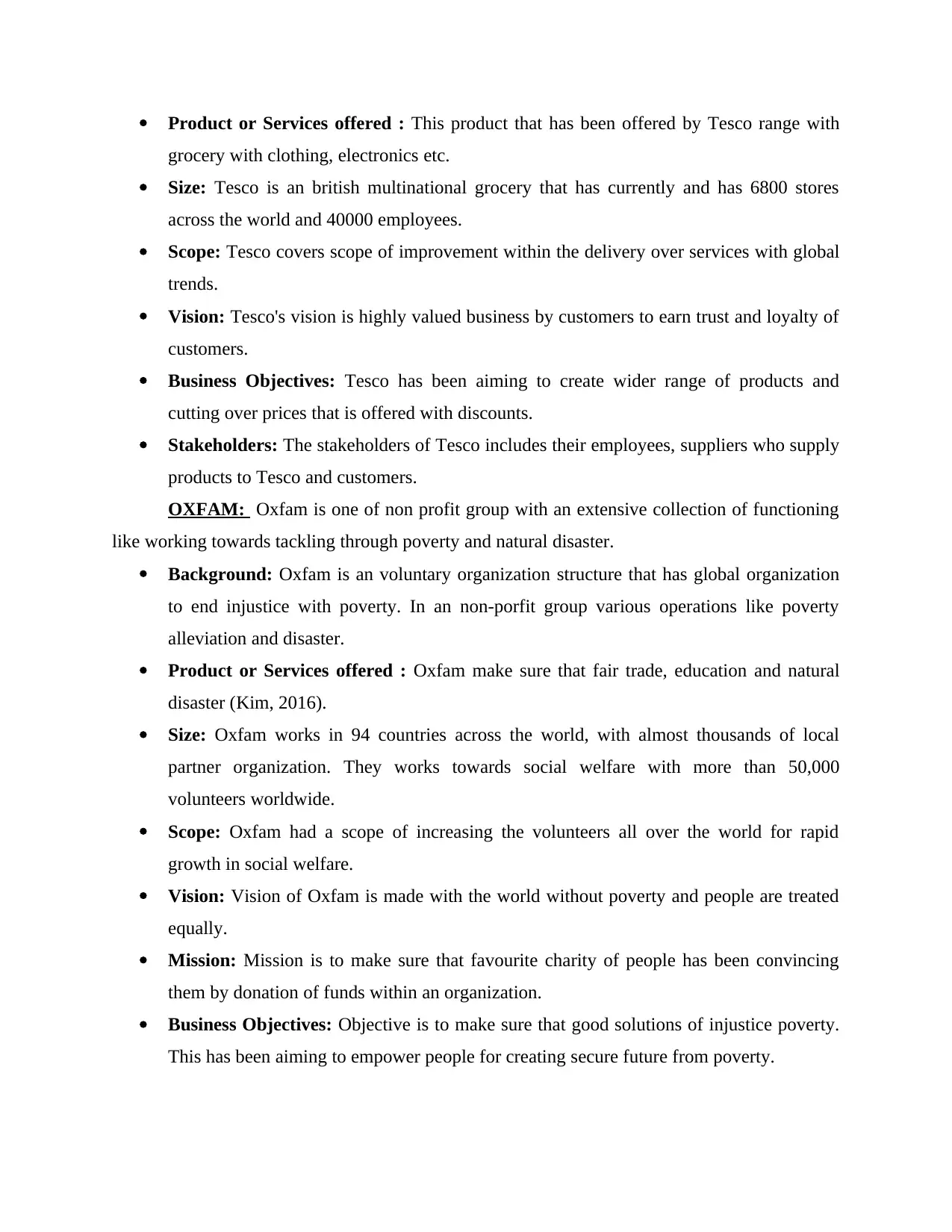
Product or Services offered : This product that has been offered by Tesco range with
grocery with clothing, electronics etc.
Size: Tesco is an british multinational grocery that has currently and has 6800 stores
across the world and 40000 employees.
Scope: Tesco covers scope of improvement within the delivery over services with global
trends.
Vision: Tesco's vision is highly valued business by customers to earn trust and loyalty of
customers.
Business Objectives: Tesco has been aiming to create wider range of products and
cutting over prices that is offered with discounts.
Stakeholders: The stakeholders of Tesco includes their employees, suppliers who supply
products to Tesco and customers.
OXFAM: Oxfam is one of non profit group with an extensive collection of functioning
like working towards tackling through poverty and natural disaster.
Background: Oxfam is an voluntary organization structure that has global organization
to end injustice with poverty. In an non-porfit group various operations like poverty
alleviation and disaster.
Product or Services offered : Oxfam make sure that fair trade, education and natural
disaster (Kim, 2016).
Size: Oxfam works in 94 countries across the world, with almost thousands of local
partner organization. They works towards social welfare with more than 50,000
volunteers worldwide.
Scope: Oxfam had a scope of increasing the volunteers all over the world for rapid
growth in social welfare.
Vision: Vision of Oxfam is made with the world without poverty and people are treated
equally.
Mission: Mission is to make sure that favourite charity of people has been convincing
them by donation of funds within an organization.
Business Objectives: Objective is to make sure that good solutions of injustice poverty.
This has been aiming to empower people for creating secure future from poverty.
grocery with clothing, electronics etc.
Size: Tesco is an british multinational grocery that has currently and has 6800 stores
across the world and 40000 employees.
Scope: Tesco covers scope of improvement within the delivery over services with global
trends.
Vision: Tesco's vision is highly valued business by customers to earn trust and loyalty of
customers.
Business Objectives: Tesco has been aiming to create wider range of products and
cutting over prices that is offered with discounts.
Stakeholders: The stakeholders of Tesco includes their employees, suppliers who supply
products to Tesco and customers.
OXFAM: Oxfam is one of non profit group with an extensive collection of functioning
like working towards tackling through poverty and natural disaster.
Background: Oxfam is an voluntary organization structure that has global organization
to end injustice with poverty. In an non-porfit group various operations like poverty
alleviation and disaster.
Product or Services offered : Oxfam make sure that fair trade, education and natural
disaster (Kim, 2016).
Size: Oxfam works in 94 countries across the world, with almost thousands of local
partner organization. They works towards social welfare with more than 50,000
volunteers worldwide.
Scope: Oxfam had a scope of increasing the volunteers all over the world for rapid
growth in social welfare.
Vision: Vision of Oxfam is made with the world without poverty and people are treated
equally.
Mission: Mission is to make sure that favourite charity of people has been convincing
them by donation of funds within an organization.
Business Objectives: Objective is to make sure that good solutions of injustice poverty.
This has been aiming to empower people for creating secure future from poverty.
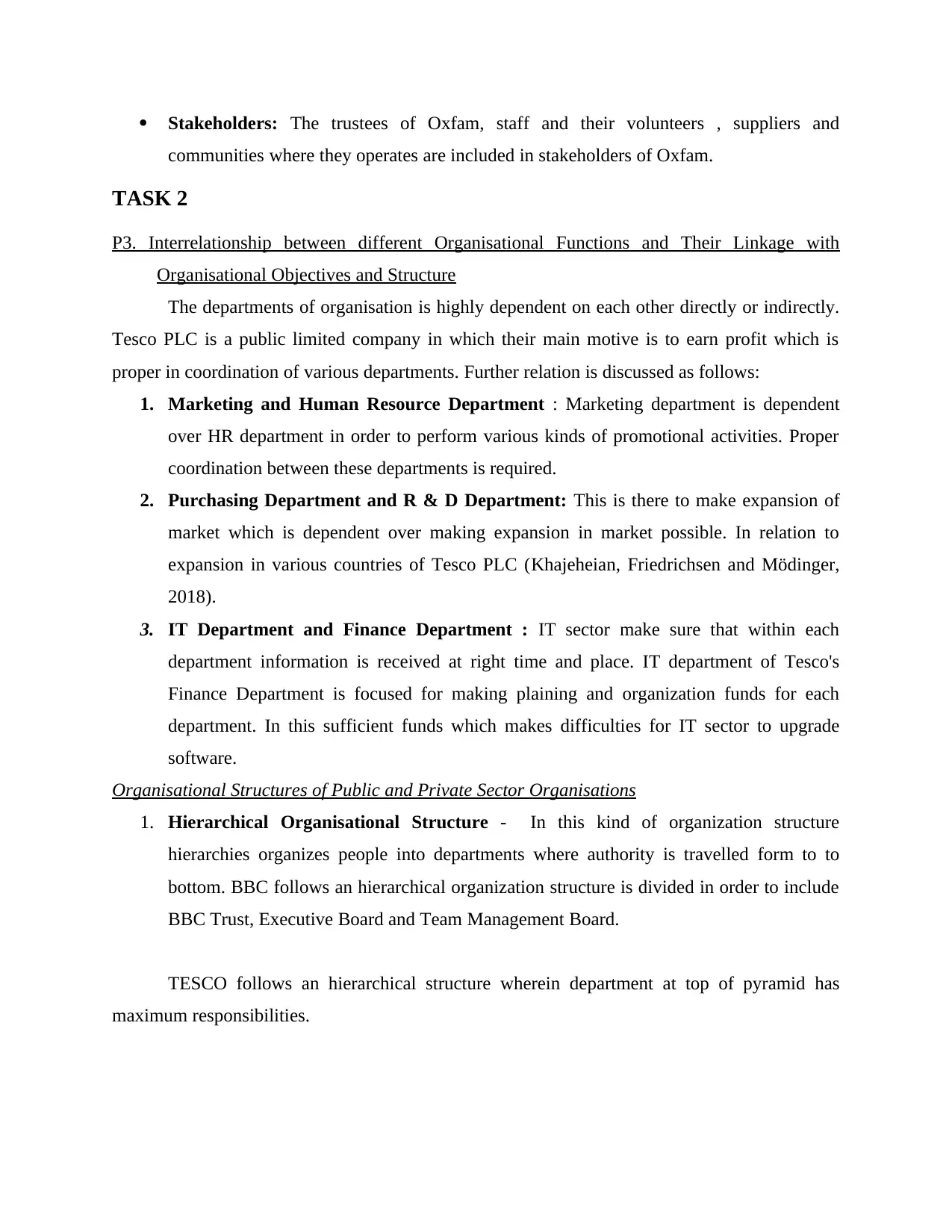
Stakeholders: The trustees of Oxfam, staff and their volunteers , suppliers and
communities where they operates are included in stakeholders of Oxfam.
TASK 2
P3. Interrelationship between different Organisational Functions and Their Linkage with
Organisational Objectives and Structure
The departments of organisation is highly dependent on each other directly or indirectly.
Tesco PLC is a public limited company in which their main motive is to earn profit which is
proper in coordination of various departments. Further relation is discussed as follows:
1. Marketing and Human Resource Department : Marketing department is dependent
over HR department in order to perform various kinds of promotional activities. Proper
coordination between these departments is required.
2. Purchasing Department and R & D Department: This is there to make expansion of
market which is dependent over making expansion in market possible. In relation to
expansion in various countries of Tesco PLC (Khajeheian, Friedrichsen and Mödinger,
2018).
3. IT Department and Finance Department : IT sector make sure that within each
department information is received at right time and place. IT department of Tesco's
Finance Department is focused for making plaining and organization funds for each
department. In this sufficient funds which makes difficulties for IT sector to upgrade
software.
Organisational Structures of Public and Private Sector Organisations
1. Hierarchical Organisational Structure - In this kind of organization structure
hierarchies organizes people into departments where authority is travelled form to to
bottom. BBC follows an hierarchical organization structure is divided in order to include
BBC Trust, Executive Board and Team Management Board.
TESCO follows an hierarchical structure wherein department at top of pyramid has
maximum responsibilities.
communities where they operates are included in stakeholders of Oxfam.
TASK 2
P3. Interrelationship between different Organisational Functions and Their Linkage with
Organisational Objectives and Structure
The departments of organisation is highly dependent on each other directly or indirectly.
Tesco PLC is a public limited company in which their main motive is to earn profit which is
proper in coordination of various departments. Further relation is discussed as follows:
1. Marketing and Human Resource Department : Marketing department is dependent
over HR department in order to perform various kinds of promotional activities. Proper
coordination between these departments is required.
2. Purchasing Department and R & D Department: This is there to make expansion of
market which is dependent over making expansion in market possible. In relation to
expansion in various countries of Tesco PLC (Khajeheian, Friedrichsen and Mödinger,
2018).
3. IT Department and Finance Department : IT sector make sure that within each
department information is received at right time and place. IT department of Tesco's
Finance Department is focused for making plaining and organization funds for each
department. In this sufficient funds which makes difficulties for IT sector to upgrade
software.
Organisational Structures of Public and Private Sector Organisations
1. Hierarchical Organisational Structure - In this kind of organization structure
hierarchies organizes people into departments where authority is travelled form to to
bottom. BBC follows an hierarchical organization structure is divided in order to include
BBC Trust, Executive Board and Team Management Board.
TESCO follows an hierarchical structure wherein department at top of pyramid has
maximum responsibilities.
Paraphrase This Document
Need a fresh take? Get an instant paraphrase of this document with our AI Paraphraser
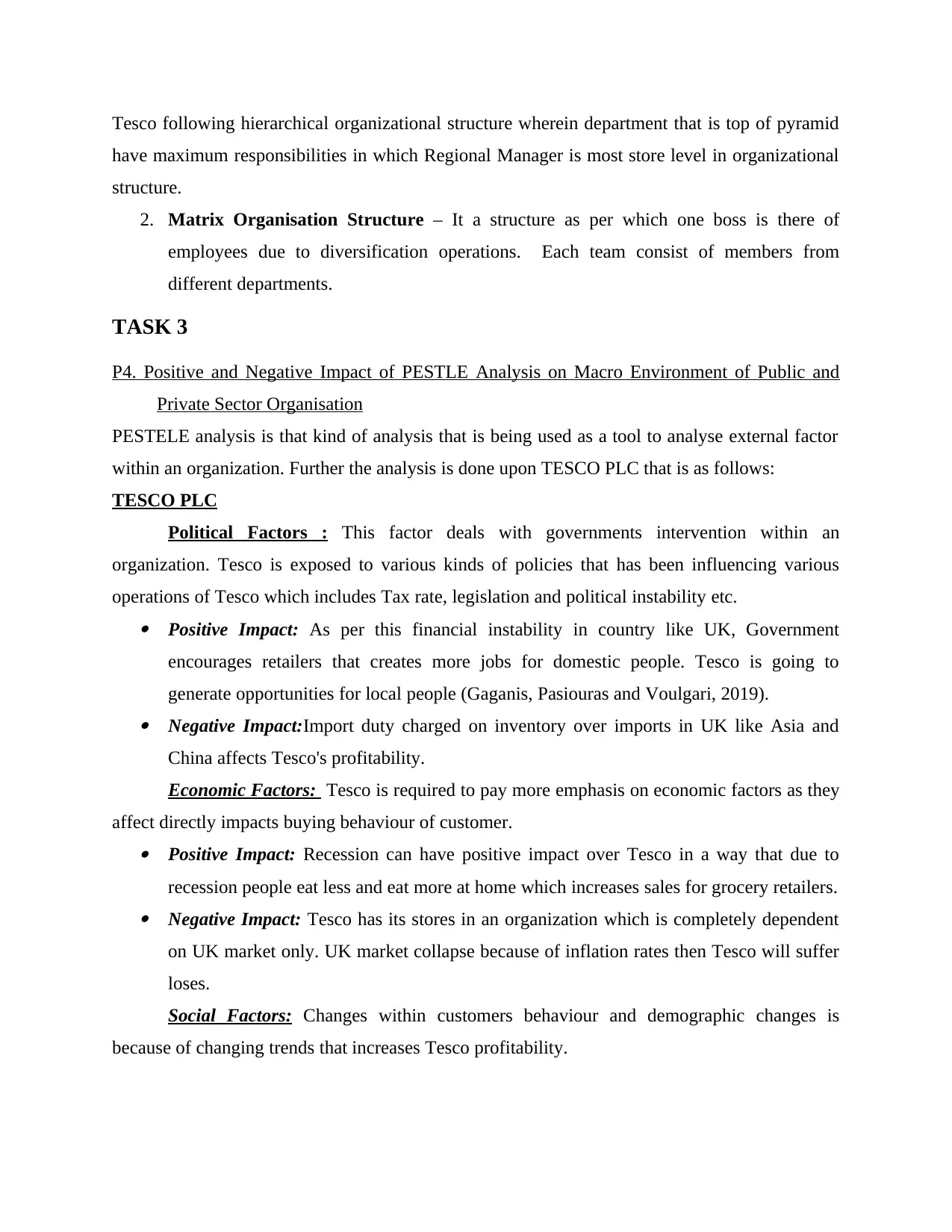
Tesco following hierarchical organizational structure wherein department that is top of pyramid
have maximum responsibilities in which Regional Manager is most store level in organizational
structure.
2. Matrix Organisation Structure – It a structure as per which one boss is there of
employees due to diversification operations. Each team consist of members from
different departments.
TASK 3
P4. Positive and Negative Impact of PESTLE Analysis on Macro Environment of Public and
Private Sector Organisation
PESTELE analysis is that kind of analysis that is being used as a tool to analyse external factor
within an organization. Further the analysis is done upon TESCO PLC that is as follows:
TESCO PLC
Political Factors : This factor deals with governments intervention within an
organization. Tesco is exposed to various kinds of policies that has been influencing various
operations of Tesco which includes Tax rate, legislation and political instability etc. Positive Impact: As per this financial instability in country like UK, Government
encourages retailers that creates more jobs for domestic people. Tesco is going to
generate opportunities for local people (Gaganis, Pasiouras and Voulgari, 2019). Negative Impact:Import duty charged on inventory over imports in UK like Asia and
China affects Tesco's profitability.
Economic Factors: Tesco is required to pay more emphasis on economic factors as they
affect directly impacts buying behaviour of customer. Positive Impact: Recession can have positive impact over Tesco in a way that due to
recession people eat less and eat more at home which increases sales for grocery retailers. Negative Impact: Tesco has its stores in an organization which is completely dependent
on UK market only. UK market collapse because of inflation rates then Tesco will suffer
loses.
Social Factors: Changes within customers behaviour and demographic changes is
because of changing trends that increases Tesco profitability.
have maximum responsibilities in which Regional Manager is most store level in organizational
structure.
2. Matrix Organisation Structure – It a structure as per which one boss is there of
employees due to diversification operations. Each team consist of members from
different departments.
TASK 3
P4. Positive and Negative Impact of PESTLE Analysis on Macro Environment of Public and
Private Sector Organisation
PESTELE analysis is that kind of analysis that is being used as a tool to analyse external factor
within an organization. Further the analysis is done upon TESCO PLC that is as follows:
TESCO PLC
Political Factors : This factor deals with governments intervention within an
organization. Tesco is exposed to various kinds of policies that has been influencing various
operations of Tesco which includes Tax rate, legislation and political instability etc. Positive Impact: As per this financial instability in country like UK, Government
encourages retailers that creates more jobs for domestic people. Tesco is going to
generate opportunities for local people (Gaganis, Pasiouras and Voulgari, 2019). Negative Impact:Import duty charged on inventory over imports in UK like Asia and
China affects Tesco's profitability.
Economic Factors: Tesco is required to pay more emphasis on economic factors as they
affect directly impacts buying behaviour of customer. Positive Impact: Recession can have positive impact over Tesco in a way that due to
recession people eat less and eat more at home which increases sales for grocery retailers. Negative Impact: Tesco has its stores in an organization which is completely dependent
on UK market only. UK market collapse because of inflation rates then Tesco will suffer
loses.
Social Factors: Changes within customers behaviour and demographic changes is
because of changing trends that increases Tesco profitability.
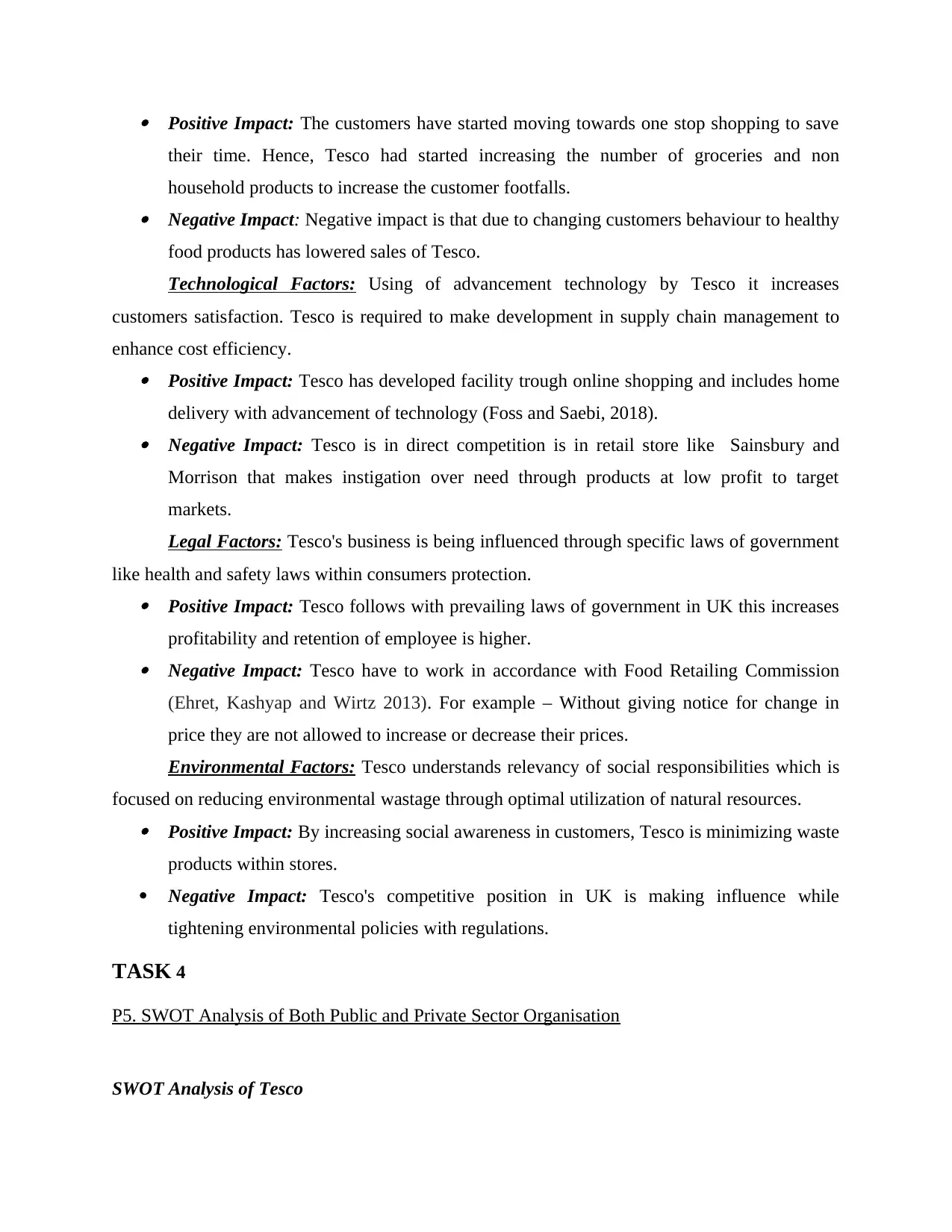
Positive Impact: The customers have started moving towards one stop shopping to save
their time. Hence, Tesco had started increasing the number of groceries and non
household products to increase the customer footfalls. Negative Impact: Negative impact is that due to changing customers behaviour to healthy
food products has lowered sales of Tesco.
Technological Factors: Using of advancement technology by Tesco it increases
customers satisfaction. Tesco is required to make development in supply chain management to
enhance cost efficiency. Positive Impact: Tesco has developed facility trough online shopping and includes home
delivery with advancement of technology (Foss and Saebi, 2018). Negative Impact: Tesco is in direct competition is in retail store like Sainsbury and
Morrison that makes instigation over need through products at low profit to target
markets.
Legal Factors: Tesco's business is being influenced through specific laws of government
like health and safety laws within consumers protection. Positive Impact: Tesco follows with prevailing laws of government in UK this increases
profitability and retention of employee is higher. Negative Impact: Tesco have to work in accordance with Food Retailing Commission
(Ehret, Kashyap and Wirtz 2013). For example – Without giving notice for change in
price they are not allowed to increase or decrease their prices.
Environmental Factors: Tesco understands relevancy of social responsibilities which is
focused on reducing environmental wastage through optimal utilization of natural resources. Positive Impact: By increasing social awareness in customers, Tesco is minimizing waste
products within stores.
Negative Impact: Tesco's competitive position in UK is making influence while
tightening environmental policies with regulations.
TASK 4
P5. SWOT Analysis of Both Public and Private Sector Organisation
SWOT Analysis of Tesco
their time. Hence, Tesco had started increasing the number of groceries and non
household products to increase the customer footfalls. Negative Impact: Negative impact is that due to changing customers behaviour to healthy
food products has lowered sales of Tesco.
Technological Factors: Using of advancement technology by Tesco it increases
customers satisfaction. Tesco is required to make development in supply chain management to
enhance cost efficiency. Positive Impact: Tesco has developed facility trough online shopping and includes home
delivery with advancement of technology (Foss and Saebi, 2018). Negative Impact: Tesco is in direct competition is in retail store like Sainsbury and
Morrison that makes instigation over need through products at low profit to target
markets.
Legal Factors: Tesco's business is being influenced through specific laws of government
like health and safety laws within consumers protection. Positive Impact: Tesco follows with prevailing laws of government in UK this increases
profitability and retention of employee is higher. Negative Impact: Tesco have to work in accordance with Food Retailing Commission
(Ehret, Kashyap and Wirtz 2013). For example – Without giving notice for change in
price they are not allowed to increase or decrease their prices.
Environmental Factors: Tesco understands relevancy of social responsibilities which is
focused on reducing environmental wastage through optimal utilization of natural resources. Positive Impact: By increasing social awareness in customers, Tesco is minimizing waste
products within stores.
Negative Impact: Tesco's competitive position in UK is making influence while
tightening environmental policies with regulations.
TASK 4
P5. SWOT Analysis of Both Public and Private Sector Organisation
SWOT Analysis of Tesco
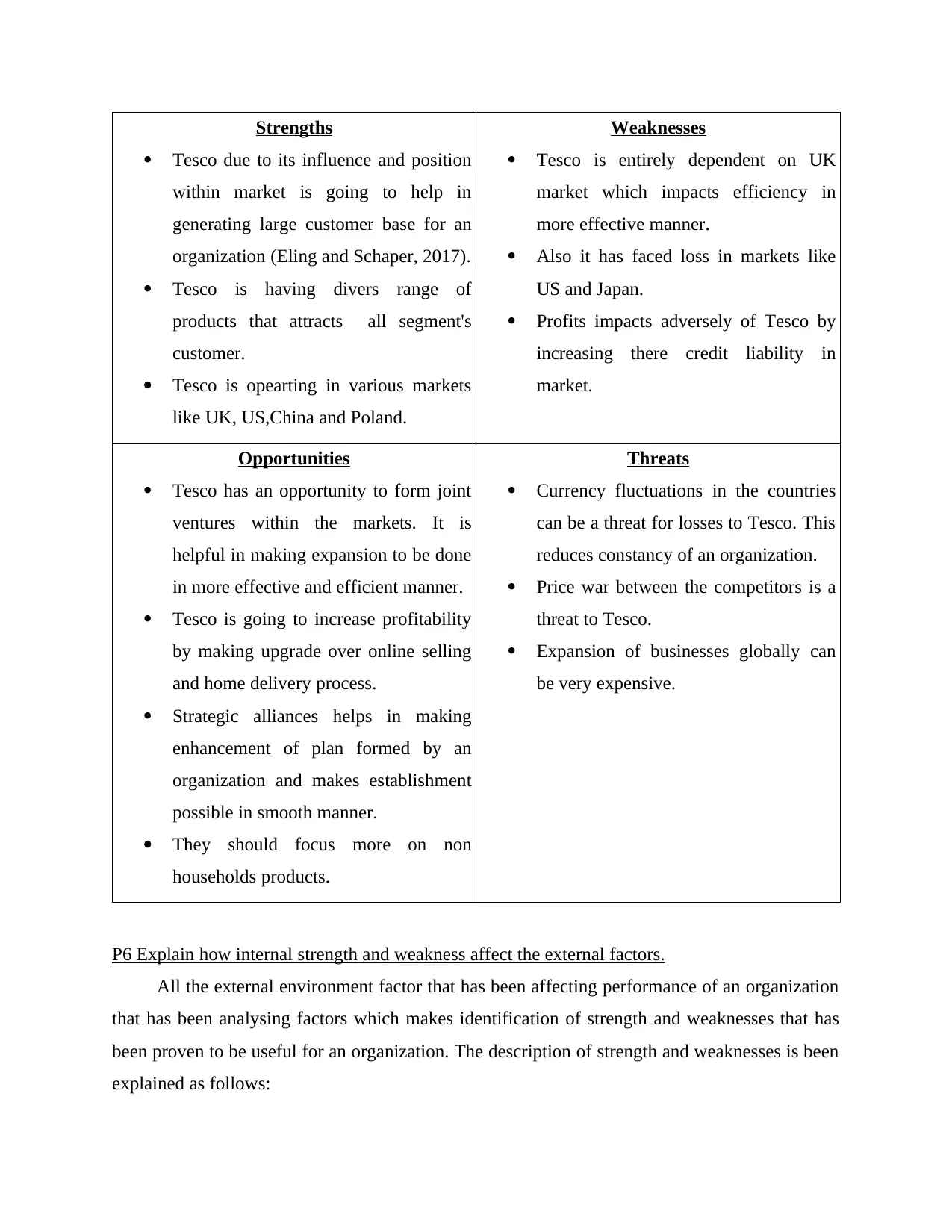
Strengths
Tesco due to its influence and position
within market is going to help in
generating large customer base for an
organization (Eling and Schaper, 2017).
Tesco is having divers range of
products that attracts all segment's
customer.
Tesco is opearting in various markets
like UK, US,China and Poland.
Weaknesses
Tesco is entirely dependent on UK
market which impacts efficiency in
more effective manner.
Also it has faced loss in markets like
US and Japan.
Profits impacts adversely of Tesco by
increasing there credit liability in
market.
Opportunities
Tesco has an opportunity to form joint
ventures within the markets. It is
helpful in making expansion to be done
in more effective and efficient manner.
Tesco is going to increase profitability
by making upgrade over online selling
and home delivery process.
Strategic alliances helps in making
enhancement of plan formed by an
organization and makes establishment
possible in smooth manner.
They should focus more on non
households products.
Threats
Currency fluctuations in the countries
can be a threat for losses to Tesco. This
reduces constancy of an organization.
Price war between the competitors is a
threat to Tesco.
Expansion of businesses globally can
be very expensive.
P6 Explain how internal strength and weakness affect the external factors.
All the external environment factor that has been affecting performance of an organization
that has been analysing factors which makes identification of strength and weaknesses that has
been proven to be useful for an organization. The description of strength and weaknesses is been
explained as follows:
Tesco due to its influence and position
within market is going to help in
generating large customer base for an
organization (Eling and Schaper, 2017).
Tesco is having divers range of
products that attracts all segment's
customer.
Tesco is opearting in various markets
like UK, US,China and Poland.
Weaknesses
Tesco is entirely dependent on UK
market which impacts efficiency in
more effective manner.
Also it has faced loss in markets like
US and Japan.
Profits impacts adversely of Tesco by
increasing there credit liability in
market.
Opportunities
Tesco has an opportunity to form joint
ventures within the markets. It is
helpful in making expansion to be done
in more effective and efficient manner.
Tesco is going to increase profitability
by making upgrade over online selling
and home delivery process.
Strategic alliances helps in making
enhancement of plan formed by an
organization and makes establishment
possible in smooth manner.
They should focus more on non
households products.
Threats
Currency fluctuations in the countries
can be a threat for losses to Tesco. This
reduces constancy of an organization.
Price war between the competitors is a
threat to Tesco.
Expansion of businesses globally can
be very expensive.
P6 Explain how internal strength and weakness affect the external factors.
All the external environment factor that has been affecting performance of an organization
that has been analysing factors which makes identification of strength and weaknesses that has
been proven to be useful for an organization. The description of strength and weaknesses is been
explained as follows:
Secure Best Marks with AI Grader
Need help grading? Try our AI Grader for instant feedback on your assignments.
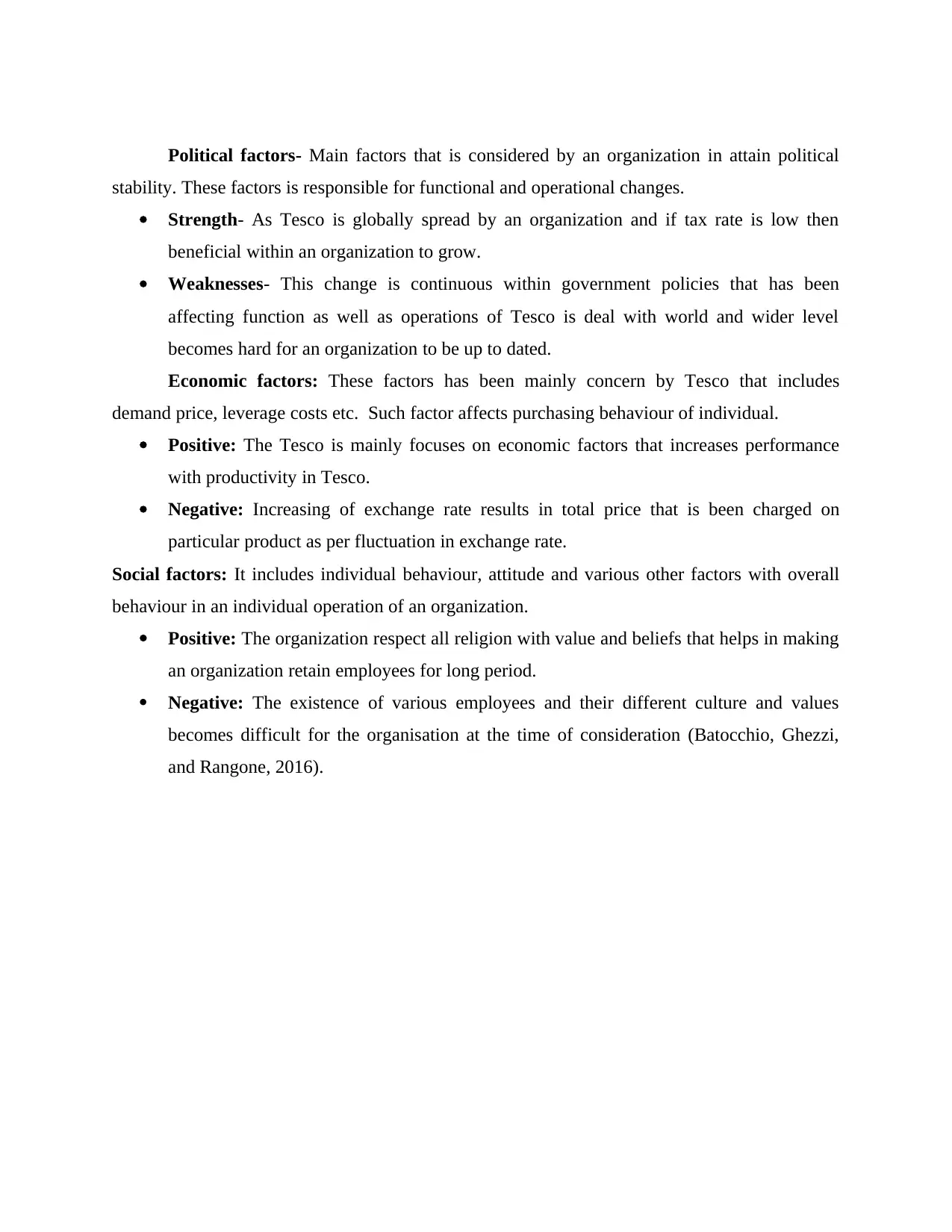
Political factors- Main factors that is considered by an organization in attain political
stability. These factors is responsible for functional and operational changes.
Strength- As Tesco is globally spread by an organization and if tax rate is low then
beneficial within an organization to grow.
Weaknesses- This change is continuous within government policies that has been
affecting function as well as operations of Tesco is deal with world and wider level
becomes hard for an organization to be up to dated.
Economic factors: These factors has been mainly concern by Tesco that includes
demand price, leverage costs etc. Such factor affects purchasing behaviour of individual.
Positive: The Tesco is mainly focuses on economic factors that increases performance
with productivity in Tesco.
Negative: Increasing of exchange rate results in total price that is been charged on
particular product as per fluctuation in exchange rate.
Social factors: It includes individual behaviour, attitude and various other factors with overall
behaviour in an individual operation of an organization.
Positive: The organization respect all religion with value and beliefs that helps in making
an organization retain employees for long period.
Negative: The existence of various employees and their different culture and values
becomes difficult for the organisation at the time of consideration (Batocchio, Ghezzi,
and Rangone, 2016).
stability. These factors is responsible for functional and operational changes.
Strength- As Tesco is globally spread by an organization and if tax rate is low then
beneficial within an organization to grow.
Weaknesses- This change is continuous within government policies that has been
affecting function as well as operations of Tesco is deal with world and wider level
becomes hard for an organization to be up to dated.
Economic factors: These factors has been mainly concern by Tesco that includes
demand price, leverage costs etc. Such factor affects purchasing behaviour of individual.
Positive: The Tesco is mainly focuses on economic factors that increases performance
with productivity in Tesco.
Negative: Increasing of exchange rate results in total price that is been charged on
particular product as per fluctuation in exchange rate.
Social factors: It includes individual behaviour, attitude and various other factors with overall
behaviour in an individual operation of an organization.
Positive: The organization respect all religion with value and beliefs that helps in making
an organization retain employees for long period.
Negative: The existence of various employees and their different culture and values
becomes difficult for the organisation at the time of consideration (Batocchio, Ghezzi,
and Rangone, 2016).
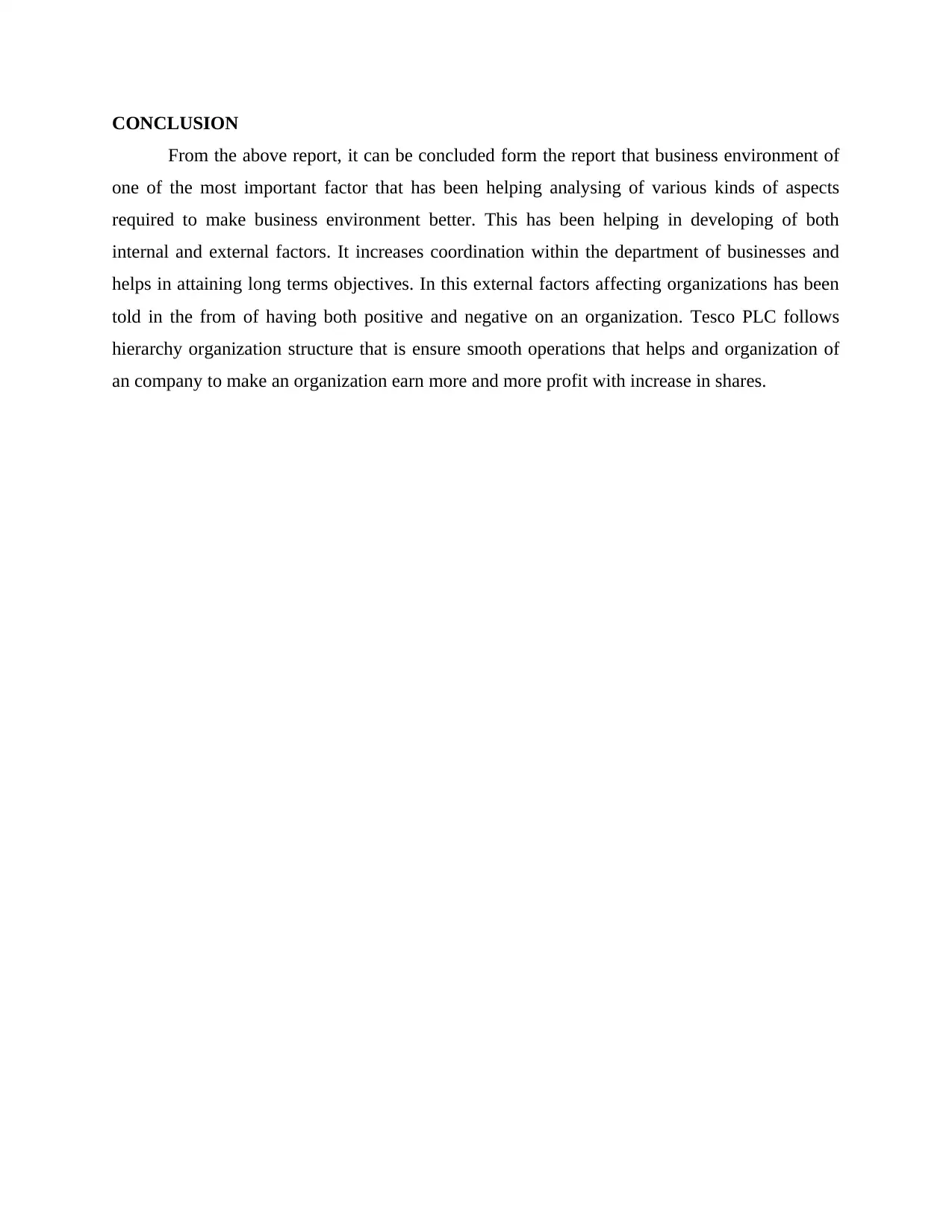
CONCLUSION
From the above report, it can be concluded form the report that business environment of
one of the most important factor that has been helping analysing of various kinds of aspects
required to make business environment better. This has been helping in developing of both
internal and external factors. It increases coordination within the department of businesses and
helps in attaining long terms objectives. In this external factors affecting organizations has been
told in the from of having both positive and negative on an organization. Tesco PLC follows
hierarchy organization structure that is ensure smooth operations that helps and organization of
an company to make an organization earn more and more profit with increase in shares.
From the above report, it can be concluded form the report that business environment of
one of the most important factor that has been helping analysing of various kinds of aspects
required to make business environment better. This has been helping in developing of both
internal and external factors. It increases coordination within the department of businesses and
helps in attaining long terms objectives. In this external factors affecting organizations has been
told in the from of having both positive and negative on an organization. Tesco PLC follows
hierarchy organization structure that is ensure smooth operations that helps and organization of
an company to make an organization earn more and more profit with increase in shares.
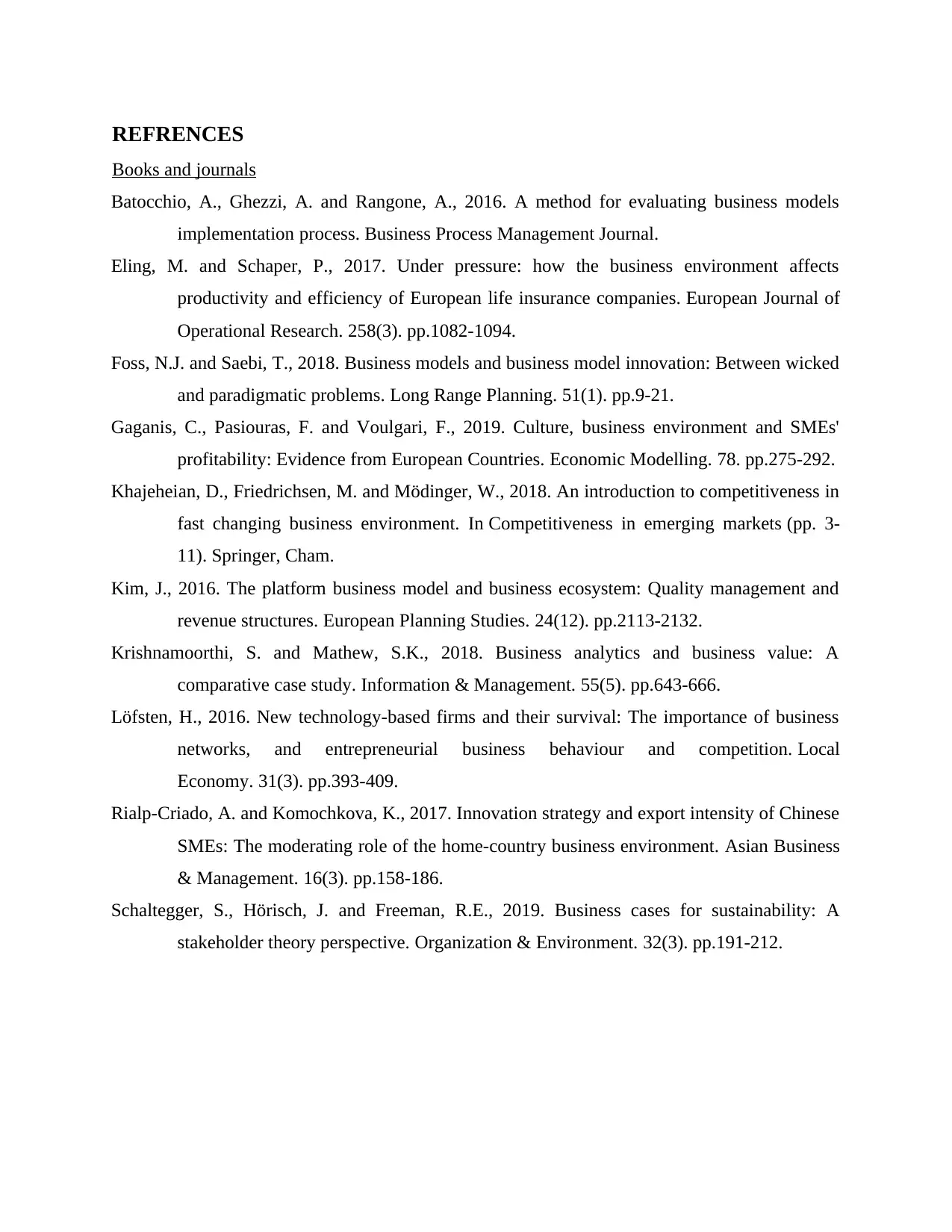
REFRENCES
Books and journals
Batocchio, A., Ghezzi, A. and Rangone, A., 2016. A method for evaluating business models
implementation process. Business Process Management Journal.
Eling, M. and Schaper, P., 2017. Under pressure: how the business environment affects
productivity and efficiency of European life insurance companies. European Journal of
Operational Research. 258(3). pp.1082-1094.
Foss, N.J. and Saebi, T., 2018. Business models and business model innovation: Between wicked
and paradigmatic problems. Long Range Planning. 51(1). pp.9-21.
Gaganis, C., Pasiouras, F. and Voulgari, F., 2019. Culture, business environment and SMEs'
profitability: Evidence from European Countries. Economic Modelling. 78. pp.275-292.
Khajeheian, D., Friedrichsen, M. and Mödinger, W., 2018. An introduction to competitiveness in
fast changing business environment. In Competitiveness in emerging markets (pp. 3-
11). Springer, Cham.
Kim, J., 2016. The platform business model and business ecosystem: Quality management and
revenue structures. European Planning Studies. 24(12). pp.2113-2132.
Krishnamoorthi, S. and Mathew, S.K., 2018. Business analytics and business value: A
comparative case study. Information & Management. 55(5). pp.643-666.
Löfsten, H., 2016. New technology-based firms and their survival: The importance of business
networks, and entrepreneurial business behaviour and competition. Local
Economy. 31(3). pp.393-409.
Rialp-Criado, A. and Komochkova, K., 2017. Innovation strategy and export intensity of Chinese
SMEs: The moderating role of the home-country business environment. Asian Business
& Management. 16(3). pp.158-186.
Schaltegger, S., Hörisch, J. and Freeman, R.E., 2019. Business cases for sustainability: A
stakeholder theory perspective. Organization & Environment. 32(3). pp.191-212.
Books and journals
Batocchio, A., Ghezzi, A. and Rangone, A., 2016. A method for evaluating business models
implementation process. Business Process Management Journal.
Eling, M. and Schaper, P., 2017. Under pressure: how the business environment affects
productivity and efficiency of European life insurance companies. European Journal of
Operational Research. 258(3). pp.1082-1094.
Foss, N.J. and Saebi, T., 2018. Business models and business model innovation: Between wicked
and paradigmatic problems. Long Range Planning. 51(1). pp.9-21.
Gaganis, C., Pasiouras, F. and Voulgari, F., 2019. Culture, business environment and SMEs'
profitability: Evidence from European Countries. Economic Modelling. 78. pp.275-292.
Khajeheian, D., Friedrichsen, M. and Mödinger, W., 2018. An introduction to competitiveness in
fast changing business environment. In Competitiveness in emerging markets (pp. 3-
11). Springer, Cham.
Kim, J., 2016. The platform business model and business ecosystem: Quality management and
revenue structures. European Planning Studies. 24(12). pp.2113-2132.
Krishnamoorthi, S. and Mathew, S.K., 2018. Business analytics and business value: A
comparative case study. Information & Management. 55(5). pp.643-666.
Löfsten, H., 2016. New technology-based firms and their survival: The importance of business
networks, and entrepreneurial business behaviour and competition. Local
Economy. 31(3). pp.393-409.
Rialp-Criado, A. and Komochkova, K., 2017. Innovation strategy and export intensity of Chinese
SMEs: The moderating role of the home-country business environment. Asian Business
& Management. 16(3). pp.158-186.
Schaltegger, S., Hörisch, J. and Freeman, R.E., 2019. Business cases for sustainability: A
stakeholder theory perspective. Organization & Environment. 32(3). pp.191-212.
1 out of 13
Related Documents
Your All-in-One AI-Powered Toolkit for Academic Success.
+13062052269
info@desklib.com
Available 24*7 on WhatsApp / Email
![[object Object]](/_next/static/media/star-bottom.7253800d.svg)
Unlock your academic potential
© 2024 | Zucol Services PVT LTD | All rights reserved.





